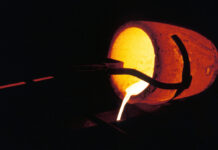
HUMMINGBIRD Resources is on course for an impressive recovery this year. The West African gold producer was “priced to fail” in February, according to CEO Dan Betts. By June, it had clawed back its losses over the previous 18 months.
“It’s been the most intense, stressful period I’ve ever been through in my career,” said Betts. “You put out your guidance and if you miss it, it’s a s**t show.” That’s what happened at Yanfolila, an 80,000 to 90,000 ounce-a-year mine in Mali. Between the fourth quarter of Hummingbird’s 2021 financial year and the third quarter of last year, it failed to hit 20,000oz per quarter for all but one. It sent all-in sustaining costs (AISC) sailing over $2,000/oz. As the only mine in the portfolio, Hummingbird was in trouble.
Betts responded by changing Yanfolila mine management and drafting in external support. A $35m finance package was also finalised, which helped keep Hummingbird in business while it completed the development of its $120m Kouroussa mine in Guinea. But the impact on the company was felt: “It will take time to earn back trust. Hummingbird was priced to go bust. The market was saying you are not going to get the mine [Kouroussa] online because Yanfolila was such a mess,” he said.
“A more experienced mining company might have foreseen the issues at Yanfolila. I’m not asking for forgiveness, I’m just asking that we learn as a mining company.”
Betts was speaking in March. By the middle of May, the company had commissioned Kouroussa, ahead of schedule and without a hitch. Commenting a week after first gold from the mine, Betts said he hoped a rerating of the share continued, although it’s critical Kouroussa builds up to nameplate capacity.
At full tilt, Kouroussa is expected to reach a run-rate of 120,000 to 140,000 oz with AISC at around $1,000/oz. There’s also exploration potential that could one day result in higher output.
Tim Huff, an analyst for Canaccord Genuity says in commissioning Kouroussa, Hummingbird has probably ensured its survival but other boxes have to be ticked this year. One is at Yanfolila, which moves to underground mining this year. This leaves Hummingbird’s balance sheet vulnerable while Kouroussa is still in ramp-up. Huff estimates probable cash of just $4m at year-end, excluding $5m/$6m of gold in inventory.
But if the balance sheet and the Yanfolila transition can be managed “the cash flow from Kouourssa alone in 2024 could be substantial enough to drive a deleveraging for a strong rerating”, he adds.
It’s all very close to the bone for Betts. “It is personal,” he says. “It’s a life’s work building this company. But Kouroussa is transformational. With a second mine you have got places to weather the storm and balance your guidance. Eventually you build more mines and rotate out of the worst assets and build a world-class mining company.
“That’s the aim.”
An important next step in achieving that might be in the Dugbe gold prospect in Liberia, which Hummingbird owns in joint venture with Pasofino Gold, a business listed on Toronto’s venture exchange. Pasofino farmed into Dugbe but the agreement gives Betts the option of swapping his firm’s 49% asset level stake for 51% control of Pasofino.
That means Hummingbird retains control over Dugbe and yet it’s a big bite of a project. Estimated in a 2022 feasibility study to produce up to 200,000 oz/year, the mine could require pre-production capital of nearly $400m. Betts says he’s “open-minded” on selling the mine given that the company has pressure on the balance sheet.
A process with RBC, the Canadian bank, is underway to see if anyone is interested in paying “a reasonable price, or partner with it”, says Betts. “I’m pretty ambivalent if I’m honest,” he says of Dugbe. “If there’s no buyer and Pasofino doesn’t want to build it I will look for another partner.”
This article first appeared in The Mining Yearbook.











